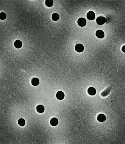SPI-Pore Polycarbonate Track Etch Membrane Filters, 25mm Dia., 3um Pore Size, Pack of 100
| Availability | Contact for Availability |
|---|---|
| Item | E3025-MB |
SPI-Pore™ Polycarbonate Track Etch Standard White Membranes
13mm (Package of 100 filters)
- Pore Diameter: 3.0
- nm: 3000
Typical applications include:
- Microfiltering of reagents, staining fluids or water prior to critical EM preparative techniques for ultramicrotomy.
- Direct observation by SEM of cells, cell organelles, fibers or contaminating particles removed from fluids.
- Ideal substrates for cell growth as a cell culture plate insert. The cells do not grow "into" the membrane, they remain at all times on the surface, making them easily removable. Liquid nutrient flows easily through the pores, giving the growing cells constant access to food. And, the cells can be easily plated.
General Specifications
Extensive information for the SPI-Pore brand is available relating different pore sizes to pore density, membrane thickness, weight, bubble point and flow rates. The guarantee on the pore size is +0%, -20%. For example, 0.6µm pore size on a membrane filter can actually have a pore size as small as .48mm but still be considered as being within the 0.6µm product range. And a 0.6 µm product can never have a pore size larger than 0.6 µm. A 0.4µm pore size product cannot ever have a pore size larger than 0.4µm. And so on.....
Pressure specifications:
With regard to the SPI-Pore™ Membrane Filters, we guarantee they will withstand pressures of at least 2000 psi when properly supported. When a membrane filter is being used in a high pressure filter holder, claim to see use pressures well in excess of 2000 psi. If the membrane is not properly supported, expect to "burst" with as little as 15-20 psi.
Optical properties:
The SPI-Pore membranes are opaque and white after etching (the starting film is transparent) because the pores refract light. PC film itself has a crystalline structure with a dual refractive index. So the light gets bent a few times as it passes through the membrane with the pores resulting in a white - opaque appearance. This is a visual, not physical or chemical change. The membrane can become clear again with either a clearing solution or a coating that cancels the effects of the light. One can also use special microscope slides of the Cyto-Clear brand, which have a coating that essentially cancels out the white color. The pores disappear when viewed under a light microscope. Most immersion oilscan serve as a clearing agent without any problems, turning the membrane from being opaque and white to clear and transparent.
Temperature limits of use:
We recommend that these membrane filters not be taken above 140 °C (284 °F).
Hydrophilic characteristics:
Polycarbonate is inherently hydrophobic and in order to increase the wetability of the membrane surface all SPI-Pore membranes are given a final treatment with PVP (polyvinylpyrrolidone). Most customers prefer PVP-treated membrane filters. However for those who believe that the PVP could interfere with their experiments, the membranes can be requested without PVP treatment as well.
It is some times asked, just how hydrophobic is the untreated membrane surface? PCTE without PVP is not truly hydrophobic like PTFE or PVDF but it is much more hydrophobic than it is hydrophilic. We are unaware of any hard data that exists in the public domain that quantitatively defines this characteristic but we have heard of contact angle measurements being made in order to get a better feel for this characteristic. PVP-Free Membrane Filters
SPI-Pore vs. Whatman/GE™ Polycarbonate Track Etch Membrane Filters
Since there is only one manufacturer in the world of the special liquid monomer from which the polycarbonate film material is made, the two brands of membrane filters are similar at the start of the process. But because different manufacturing processes are used different thicknesses of base material film are needed. For most pore sizes, the membrane thickness of the SPI-Pore membranes is thinner than the Whatman/GE™ brand. This has important implications on flow rates.
Binding of macromolecules to the membrane surface:
We are often times asked what is the affinity of nucleic acids molecule (DNA, RNA) to bind to polycarbonate membrane filter. The affinity is based strictly on the electrical charge on the PCTE membrane itself, be it SPI-Pore or Whatman/GE™. Either brand of PCTE is easily coated in order to increase affinity but other than that it is strictly based on how the DNA/RNA is affected by the intrinsic charge on the surface of the membrane.
Holding the membrane filters:
All membrane filters offered by SPI Supplies irrespective of their construction, must be used in conjunction with a specially made membrane filter holder.

